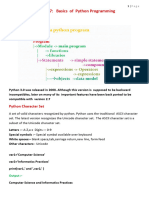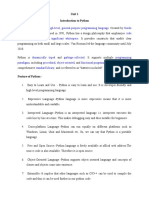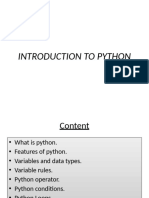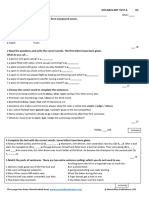Lesson 4 Python Basics
Uploaded by
flyware600Lesson 4 Python Basics
Uploaded by
flyware600Big Data Analytics Lesson 4
Lesson 4: Python Basics
Lesson 4: Python Basics................................................................................................................................ 1
4.1. Introduction .................................................................................................................................. 2
4.2. Indentation and blocks................................................................................................................. 2
4.3. Comments..................................................................................................................................... 2
4.4. Variables and Constants............................................................................................................... 3
4.5. Data types and type casting ......................................................................................................... 3
4.6. Operators ...................................................................................................................................... 4
4.6.1. Arithmetic Operators ............................................................................................................ 4
4.6.2. Assignment Operators .......................................................................................................... 4
4.6.3. Comparison Operators .......................................................................................................... 4
4.6.4. Logical Operators .................................................................................................................. 4
4.7. Functions ...................................................................................................................................... 5
4.8. Classes and Objects ...................................................................................................................... 5
Lesson 4: Review Questions ..................................................................................................................... 5
Compiled by: Karari E.K email: cats.mwalimu@gmail.com 1
Big Data Analytics Lesson 4
4.1. Introduction
Python can be executed by writing directly in the command line or y creating a python file on the server,
using the .py file extension, and running it in the command line. You can also run Python from a
Graphical User Interface (GUI) environment as well, if you have a GUI application / IDE on your system
that supports Python.
4.2. Indentation and blocks
Indentation refers to the spaces at the beginning of a code line.
Where in other programming languages the indentation in code is for readability only, the
indentation in Python is very important.
Python uses indentation to indicate a block of code.
Example
if 5 > 2:
print("Five is greater than two!")
Python will give you an error if you skip the indentation:
Example
Syntax Error:
if 5 > 2:
print("Five is greater than two!")
The number of spaces is up to you as a programmer, the most common use is four, but it has to
be at least one.
Example
if 5 > 2:
print("Five is greater than two!")
if 5 > 2:
print("Five is greater than two!")
You have to use the same number of spaces in the same block of code, otherwise Python will
give you an error:
Example
Syntax Error:
if 5 > 2:
print("Five is greater than two!")
print("Five is greater than two!")
4.3. Comments
Python has commenting capability for the purpose of in-code documentation.
Comments start with a #, and Python will ignore them.
Comments can be used to explain Python code or to prevent Python from executing code.
Comments can be used to make the code more readable.
Comments can be used to prevent execution when testing code.
Python does not really have a syntax for multi-line comments. To add a multiline comment you could
insert a # for each line
Compiled by: Karari E.K email: cats.mwalimu@gmail.com 2
Big Data Analytics Lesson 4
Example
Comments in Python:
#This is a comment
#written in
#more than just one line
print("Hello, World!") #Another comment
4.4. Variables and Constants
Variables are containers for storing data values. Python has no command for declaring a variable. A
variable is created the moment you first assign a value to it. Variables do not need to be declared with
any particular type, and can even change type after they have been set.
Example
x = 4 # x is of type int
x = "Sally" # x is now of type str
print(x)
You can get the data type of a variable with the type()function-print(type(x)).
String variables can be declared either by using single or double quotes:
Example
x = "John"
# is the same as
x = 'John'
Variable names are case-sensitive.
Python allows you to assign a single value to several variables simultaneously.
x=y=4
In Python, constants are usually declared and assigned in a module. Here, the module is a new file
containing variables, functions, etc which is imported to the main file. Inside the module, constants are
written in all capital letters and underscores separating the words.
4.5. Data types and type casting
In programming, data type is an important concept.
Variables can store data of different types, and different types can do different things.
Python has the following data types built-in by default, in these categories:
Text Type: str
Numeric Types: int, float, complex
Sequence Types: list, tuple, range
Mapping Type: dict
Set Types: set, frozenset
Boolean Type: bool
Compiled by: Karari E.K email: cats.mwalimu@gmail.com 3
Big Data Analytics Lesson 4
Binary Types: bytes, bytearray, memoryview
None Type: NoneType
If you want to specify the data type, it can be done with casting:
Example
x = str(3) # x will be '3'
y = int(3) # y will be 3
z = float(3) # z will be 3.0
w = float("4.2") # w will be 4.2
4.6. Operators
Operators are used to perform operations on variables and values. They can be grouped into:
arithmetic, assignment, comparison and logical operators
4.6.1. Arithmetic Operators
Arithmetic operators are used with numeric values to perform common mathematical operations.
Operator Name
+ Addition
- Subtraction
* Multiplication
/ Division
% Modulus
** Exponentiation
// Floor division
4.6.2. Assignment Operators
Assignment operators are used to assign values to variables.
Examples: x=5, x+=1.
4.6.3. Comparison Operators
Comparison operators are used to compare two values.
Operator Name
== Equal
!= Not equal
> Greater than
< Less than
>= Greater than or equal to
<= Less than or equal to
4.6.4. Logical Operators
Logical operators are used to combine conditional statements i.e AND, OR, NOT.
Compiled by: Karari E.K email: cats.mwalimu@gmail.com 4
Big Data Analytics Lesson 4
4.7. Functions
A function is a block of code which only runs when it is called. You can pass data, known as parameters,
into a function. A function can return data as a result.
A function is defined using the def keyword:
def my_function():
print("Hello from a function")
To call a function, use the function name followed by parenthesis:
my_function()
Information can be passed into functions as arguments.
Arguments are specified after the function name, inside the parentheses. You can add as many
arguments as you want, just separate them with a comma.
Example
This function expects 2 arguments, and gets 2 arguments:
def my_function(fname, lname):
print(fname + " " + lname)
my_function("Emil", "Refsnes")
If you try to call the function with 1 or 3 arguments, you will get an error.
4.8. Classes and Objects
Python is an object oriented programming language. Almost everything in Python is an object, with its
properties and methods. A Class is like an object constructor, or a "blueprint" for creating objects
To create a class, use the keyword class.
Example: Create a class named MyClass, with a property named x:
class MyClass:
x=5
Now we can use the class named MyClass to create objects.
p1 = MyClass()
print(p1.x)
Lesson 4: Review Questions
1. State rules of naming variables in Python.
2. Write a function that accepts three values and return their product.
3. Explain the difference between = and = =. Give examples.
4. Create a class named Person, use the __init__() function to assign values for name and age.
5. Explain the use of keyword pass.
Compiled by: Karari E.K email: cats.mwalimu@gmail.com 5
You might also like
- Cours Python - Seance1 - Introduction Et Concepts de BaseNo ratings yetCours Python - Seance1 - Introduction Et Concepts de Base12 pages
- Python Basics: Recycling Nicole's Slides From Year 2016No ratings yetPython Basics: Recycling Nicole's Slides From Year 201645 pages
- Isom 3400 - Python For Business Analytics 2. Python Basics: Yingpeng Robin ZhuNo ratings yetIsom 3400 - Python For Business Analytics 2. Python Basics: Yingpeng Robin Zhu55 pages
- Python, Django, Pandas, NumPy Roadmap_ (1)No ratings yetPython, Django, Pandas, NumPy Roadmap_ (1)23 pages
- Python Notes Class X Artificial IntellgenceNo ratings yetPython Notes Class X Artificial Intellgence9 pages
- Python Variable, Data Types and OperatorsNo ratings yetPython Variable, Data Types and Operators42 pages
- Udemy, Inc. Is An American Massive Open OnlineNo ratings yetUdemy, Inc. Is An American Massive Open Online39 pages
- Mastering Python: A Comprehensive Guide for Beginners and ExpertsFrom EverandMastering Python: A Comprehensive Guide for Beginners and ExpertsNo ratings yet
- Python for Data Science: Data Science Mastery by Nikhil Khan, #1From EverandPython for Data Science: Data Science Mastery by Nikhil Khan, #1No ratings yet
- Project:-765Kv S/C Raigarh-Champa TL.: Safety Aspects of Conductor Installations IN Transmission LineNo ratings yetProject:-765Kv S/C Raigarh-Champa TL.: Safety Aspects of Conductor Installations IN Transmission Line37 pages
- Aveo T250&T255 ANTI-THEFT CONTROL SYSTEM CIRCUITNo ratings yetAveo T250&T255 ANTI-THEFT CONTROL SYSTEM CIRCUIT5 pages
- Complete Wellbeing From Woodland: A Critical Exploration of Links Between Trees and Human Health Alice Goodenough PDF For All Chapters100% (4)Complete Wellbeing From Woodland: A Critical Exploration of Links Between Trees and Human Health Alice Goodenough PDF For All Chapters62 pages
- Welcome To PDF Hero: Explore The All-In-One PDF Editor For Everyday Work!No ratings yetWelcome To PDF Hero: Explore The All-In-One PDF Editor For Everyday Work!16 pages
- Steven Saylor - Gordianus - Something Fishy in PompeiiNo ratings yetSteven Saylor - Gordianus - Something Fishy in Pompeii7 pages
- University of Nigeria Teaching Hospital: Ituku - Ozalla, P.M.B. 01129, EnuguNo ratings yetUniversity of Nigeria Teaching Hospital: Ituku - Ozalla, P.M.B. 01129, Enugu1 page
- Disaster Recovery and Emergency Communications Via Broadband SatelliteNo ratings yetDisaster Recovery and Emergency Communications Via Broadband Satellite2 pages
- VAS6161 - VAS 6161 Battery Tester Instruction ManualNo ratings yetVAS6161 - VAS 6161 Battery Tester Instruction Manual27 pages
- Ancient Rome Evan-Moor Educational Publishers All Chapters Instant Download100% (5)Ancient Rome Evan-Moor Educational Publishers All Chapters Instant Download61 pages
- CSA Mod 3-Part 2 Notes (Cache Coherence)No ratings yetCSA Mod 3-Part 2 Notes (Cache Coherence)19 pages

























































































